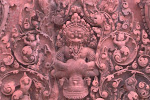| Pre-Angkor stone-carving remains very modern affair | | |
| Written by STEPHANIE MEE | |
| Monday, 26 January 2009 The Phnom Penh Post | |
| Nearly lost amid the violence and cultural nihilism of the Khmer Rouge, stone carvers continue to find markets for their ancient tradecraft Photo by: Stephanie Mee Veteran stone-carver Touey puts the finishing touches on a statue in Phnom Penh. Common themes in ancient Khmer sculpture include deities from the Ramayana (in Khmer, the Ream Ker), such as Vishnu, Brahma and Hanuman, as well as varying images of the Buddha reclining, standing with one palm facing outwards to signify protection from fear, or sitting in meditation in front of a giant naga (or snake) with multiple heads. Not uncommon was the representation of the Khmer royalty or aristocracy in the form of various stone deities, a clear example of which can be seen in the massive stone heads at the Bayon temple at the Angkor Wat complex, which combine the image of King Jayavarman VII and Buddha. During the Khmer Rouge regime, many skilled artists were either forced to work in the rice fields or perished in the horrors that marked the Democratic Kampuchea period and the civil war that followed. Those who survived had little means to begin carving again. Cultural revival Fortunately, the 1990s were a period of reconstruction, rehabilitation and revival in Cambodia, and numerous NGOs began helping disadvantaged Cambodian people to reintegrate themselves into the workforce. In particular, Chantiers-Ecoles de Formation Professionelle, and its offshoot Artisans d'Angkor, were established to help train underprivileged youth in the country's many almost-extinct Khmer artistic traditions and techniques, including stone-carving. Today, large stone-carving production centres can be found mainly in the municipalities and provinces of Pursat, Preah Vihear, Kampong Thom, Banteay Meanchey, Siem Reap and Phnom Penh, though smaller centres exist throughout the Kingdom. In Phnom Penh, the bulk of stone-carving workshops can be found on Street 178, across the road from Wat Sarawan. I learned from my uncle and other family members in our village. Det Ourn, 16, works out of his uncle's workshop, Kon Khmer Sculpture on Street 178. "I learned from my uncle and other family members in our village," Det Ourn said. "First, I just watched others carving and I followed what they did. Then, I began to practise on my own, and today I can make any kind of statue." Patience is key One medium-sized Buddha statue can take up to one month to complete and involves considerable patience, Det Ourn said. "First, you paint an outline of the shape on the block of stone and begin to carve carefully with a chisel. When the rough shape has been chiselled out, you can begin to sand and polish the stone into the smooth, finished image. For extra details like eyes, mouths, creases in cloth and things like flowers, you can use a fine, small chisel or an electric sander," he said. One veteran artisan says a variety of markets exist for today's carvers. "The Angkorian, or traditional styles from the Ream Ker, are mostly bought for private homes, restaurants or businesses, while the traditional Buddhas and the modern, life-sized Buddhas and monks with alms bowls are generally bought for temples," said a veteran stone-carver from the Ta Phrom shop who goes by the name Touey. Touey learned the art of stone-carving from his brother, who had learned it from their grandfather. Touey and his family were forced to work in the rice fields under the Khmer rouge. "Fortunately, my family remembered the traditional ways and we began carving again in the late 1980's," Touey said. Most statues are made from sandstone from Preah Vihear or Kampong Thom provinces, while high-quality marble is sourced mainly from Pursat province, where stone-carving has become a major industry. Statues range from grainy pink and grey sandstone pieces to smoothly polished marble, shining in colours from jade green to crimson to pale yellow. Thanks to the perseverance of artisans and NGOs, stone-carving is on the rise again, and talented artists like Det Ourn and Touey can make a living doing what their ancestors have done for centuries before. |


No comments:
Post a Comment